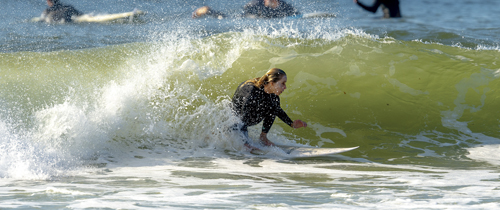
Physical Therapy

Have you recently checked the surf only to end up on the bench instead, missing out on great waves due to an orthopedic injury? Physical injuries, especially if you are active in and out of the water are inevitable, and surfers must be mindful of repetitive movements that will eventually cause pain. Preventing injury and staying fit on that surfboard will keep you off the bench and in the line-up.
Paddling: Working against gravity to arch your back and paddle a long or short board is counter to what we do most of the day; sit, drive, roll our shoulders forward (just think of your posture when texting). The lower back takes the brunt of the work to hold you up, making us susceptible to joint andmuscle irritation and lower back strains. Your upper back or thoracic spine is going to get stronger from all that paddling but also can become irritated from muscle overuse. Shortboarders have an extra opportunity to injure ligaments in their knees, depending on the amount of twisting and style used at high speed.
 If your board is too wide for your shoulders, you put more strain on your mid-back to find a full range of motion to paddle and pop up. Shoulder strain will make you vulnerable to overuse, possibly leading to rotator-cuff impingement and tendonitis. The body will compensate, putting pressure on the shoulder joint to get the mobility needed to catch that wave. If you are the infrequent surfer or not doing enough cross training out of the water, you may not have adequate strength for those longer sessions, like jumping into a 10K when you have not been running regularly.
If your board is too wide for your shoulders, you put more strain on your mid-back to find a full range of motion to paddle and pop up. Shoulder strain will make you vulnerable to overuse, possibly leading to rotator-cuff impingement and tendonitis. The body will compensate, putting pressure on the shoulder joint to get the mobility needed to catch that wave. If you are the infrequent surfer or not doing enough cross training out of the water, you may not have adequate strength for those longer sessions, like jumping into a 10K when you have not been running regularly.
Prevention: We know sleep above all else is the foundation for healing, optimal use of energy, awareness, and strength, followed by eating a balanced diet. Working out and surfing often are not enough without proper rest and nutrition. Warm up before you jump into the water. Biking to the beach, walking, and stretching (preferably not in front of a group of people checking the surf from the sand and benches) are options. Planks are excellent, as are yoga poses that facilitate mobility in the hips and focus on the shoulders and upper back. Be sure to pay attention to your weaker side as your body will work harder to find balance when one side is more powerful. Be aware of how much time you are sedentary when you are not in the water, and aim for more frequent activity, exercise, and variety in how you sit, stand, and move throughout the day.
Preparation: You are on a surf trip and want to be in the water as much as possible, or suddenly there is a swell when it has been flat for weeks. Notice if you are encouraging inflammation in the muscles or trying to push through pain from an injury. Winter months of surfing on the east end means shoehorning into your 5/4, paddling in thicker neoprene and losing mobility in the neck due to the hood. While it makes you stronger for those months surfing without all that gear, keep in mind your body is working harder to counter the blood moving from your limbs to your chest when you are immersed in the chilly ocean. Pressure on your heart raises your blood pressure, particularly when you are underwater and must hold your breath, slowing down the heart. A healthy blood pressure will also help resist the shock and survival mechanism released by your body when you hit the cold water. Consistently striving to improve your balance, posture and core strength will assist your body in keeping composure ion the board. Excellent physical therapy will assist in strengthening these areas if you are injured, and physical practices like yoga and strength training will help prevent them in the first place…if you want to be or stay a regular in the lineup. Happy surfing!

